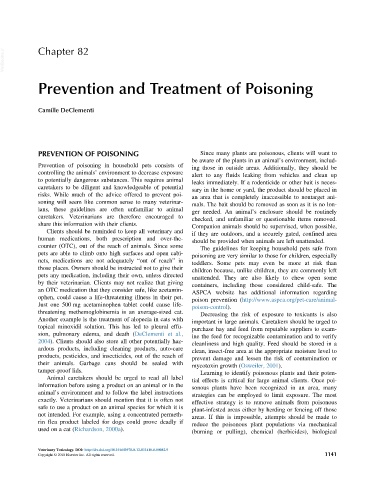Page 1210 - Veterinary Toxicology, Basic and Clinical Principles, 3rd Edition
P. 1210
VetBooks.ir Chapter 82
Prevention and Treatment of Poisoning
Camille DeClementi
PREVENTION OF POISONING Since many plants are poisonous, clients will want to
be aware of the plants in an animal’s environment, includ-
Prevention of poisoning in household pets consists of
ing those in outside areas. Additionally, they should be
controlling the animals’ environment to decrease exposure
alert to any fluids leaking from vehicles and clean up
to potentially dangerous substances. This requires animal
leaks immediately. If a rodenticide or other bait is neces-
caretakers to be diligent and knowledgeable of potential
sary in the home or yard, the product should be placed in
risks. While much of the advice offered to prevent poi-
an area that is completely inaccessible to nontarget ani-
soning will seem like common sense to many veterinar- mals. The bait should be removed as soon as it is no lon-
ians, these guidelines are often unfamiliar to animal
ger needed. An animal’s enclosure should be routinely
caretakers. Veterinarians are therefore encouraged to
checked, and unfamiliar or questionable items removed.
share this information with their clients.
Companion animals should be supervised, when possible,
Clients should be reminded to keep all veterinary and
if they are outdoors, and a securely gated, confined area
human medications, both prescription and over-the-
should be provided when animals are left unattended.
counter (OTC), out of the reach of animals. Since some
The guidelines for keeping household pets safe from
pets are able to climb onto high surfaces and open cabi-
poisoning are very similar to those for children, especially
nets, medications are not adequately “out of reach” in
toddlers. Some pets may even be more at risk than
those places. Owners should be instructed not to give their
children because, unlike children, they are commonly left
pets any medication, including their own, unless directed
unattended. They are also likely to chew open some
by their veterinarian. Clients may not realize that giving
containers, including those considered child-safe. The
an OTC medication that they consider safe, like acetamin-
ASPCA website has additional information regarding
ophen, could cause a life-threatening illness in their pet.
poison prevention (http://www.aspca.org/pet-care/animal-
Just one 500 mg acetaminophen tablet could cause life-
poison-control).
threatening methemoglobinemia is an average-sized cat.
Decreasing the risk of exposure to toxicants is also
Another example is the treatment of alopecia in cats with
important in large animals. Caretakers should be urged to
topical minoxidil solution. This has led to pleural effu-
purchase hay and feed from reputable suppliers to exam-
sion, pulmonary edema, and death (DeClementi et al.,
ine the feed for recognizable contamination and to verify
2004). Clients should also store all other potentially haz-
cleanliness and high quality. Feed should be stored in a
ardous products, including cleaning products, auto-care
clean, insect-free area at the appropriate moisture level to
products, pesticides, and insecticides, out of the reach of
prevent damage and lessen the risk of contamination or
their animals. Garbage cans should be sealed with
mycotoxin growth (Osweiler, 2001).
tamper-proof lids.
Learning to identify poisonous plants and their poten-
Animal caretakers should be urged to read all label
tial effects is critical for large animal clients. Once poi-
information before using a product on an animal or in the
sonous plants have been recognized in an area, many
animal’s environment and to follow the label instructions
strategies can be employed to limit exposure. The most
exactly. Veterinarians should mention that it is often not
effective strategy is to remove animals from poisonous
safe to use a product on an animal species for which it is
plant-infested areas either by herding or fencing off those
not intended. For example, using a concentrated permeth-
areas. If this is impossible, attempts should be made to
rin flea product labeled for dogs could prove deadly if
reduce the poisonous plant populations via mechanical
used on a cat (Richardson, 2000a).
(burning or pulling), chemical (herbicides), biological
Veterinary Toxicology. DOI: http://dx.doi.org/10.1016/B978-0-12-811410-0.00082-9
Copyright © 2018 Elsevier Inc. All rights reserved. 1141

